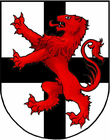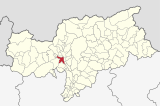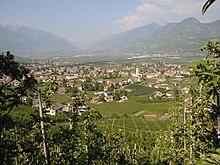Lana
| Lana | |
|---|---|
| (ital. Lana ) | |
| coat of arms | map |
| State : | Italy |
| Region : | Trentino-South Tyrol |
| Province : | Bolzano - South Tyrol |
| District community : | Burgrave Office |
|
Inhabitants : (VZ 2011 / 31.12.2019) |
11.255 / 12.467 |
|
Language groups : (according to 2011 census ) |
91.84% German 7.90% Italian 0.26% Ladin |
| Coordinates | 46 ° 37 ' N , 11 ° 9' E |
| Altitude : | 254– 1913 m slm (center: 310 m slm ) |
| Surface: | 36.1 km² |
| Permanent settlement area: | 18.3 km² |
| Parliamentary groups : | Lana , Pawigl, Völlan , Ackpfeif |
| Neighboring municipalities: | Burgstall , Gargazon , Meran , St. Pankraz , Tisens , Tscherms |
| Partnership with : | Telfs ( A ), Idstein ( D ), Feuchtwangen ( D ) |
| Postal code : | 39011 |
| Area code : | 0473 |
| ISTAT number: | 021041 |
| Tax number: | 82007030214 |
| Mayor (2015): | Harald Stauder ( SVP ) |
Lana ([ ˈlaːna ]; Italian also Lana ) is an Italian market town with 12,467 inhabitants (as of December 31, 2019) in South Tyrol, south of Merano .
Lana is the seventh largest municipality in South Tyrol in terms of inhabitants .
geography
Lana is located in the Burggrafenamt in the Etschtal , more precisely on the southwestern edge of the Merano valley basin at the exit of the Ulten Valley . The elongated village of Lana (divided into Oberlana, Mitterlana and Niederlana) is about 300 m above sea level on the orographic right side of the Etsch on a flat alluvial fan of the Falschauer . To the northwest of the town center, the municipality reaches its highest point at around 1900 m on the ridge of the Vigiljoch , which in the Zufrittkamm forms the north-easternmost foothill of the Ortler Alps . A south-facing slope offers space for the small village of Pawigl ( 1200 m ). In the southwest is on a mountain terrace , the fraction Foiana ( 700 m ). Behind it the terrain rises to almost 1700 m to the wooded, northernmost foothills of the Nonsberg group .
history
The first prehistoric settlements were on the hilltops Kobaltbühel, Silackerbühel, Burghügel Braunsberg, Brandis and Leonburg. In the 9th century, the two churches of St. Georg and St. Margarethen were built. Lana (Lenon) was first mentioned in a document in 990.
The lords of Lana were ministerials of the Guelphs who owned land in Lana. According to a document from 1273, in 1082 a Berthold von Lana bequeathed his goods to the Welf monastery Weingarten . The Lords of Lana, whose property was in Niederlana, also exercised bailiwick rights over South Tyrolean goods belonging to the Tegernsee Monastery , also a Guelf foundation. They belonged to the higher-ranking ministerial nobility, as the foundation of the Church of St. Jakob in Grissian in 1142 shows. The original seat of those of Lana was probably in Niederlana near the Church of the Assumption of Mary . Between 1140 and 1153 Prantoch von Lounon (Lana) with his sons Hildebrand and Heinrich (senex Brandhoch de Loeinnon filiique sui Hiltebrandus et Heinricus ) appear for the first time in a document . At the end of the 12th to the beginning of the 13th century they built two hilltop castles , Brandis Castle and Lanaburg ( Leonburg ), both initially owned by their own . The two castles were first mentioned in a document in 1236. From the beginning of the 13th century, the lords of Lana branched out into several families, each named after their seat, including those of Brandis , von Lanaburg, von Braunsberg , von Marling - Lebenberg and von Werrenberg (on the Werrenberg, also tower zu Called Völlan ). They all had a red lion in their coat of arms and had common lead names such as Berthold, Schwiker, Hildebrand, Konrad, Burghard, Ulrich, Adelheid. In 1295, the two own castles had to be given to Prince Meinhard II of Tyrol as a fief after he threatened siege and fire with a blide . In 1423, three Brandis brothers received the northern part of the previously presumably burned out Leonburg and in 1426 this fell entirely to the Brandis, the Leonburg branch of the family died out in 1462.
Brandis Castle fell into ruins at the beginning of the 19th century, whereupon the Counts of Brandis built Neubrandis Castle a little below, which, like Leonburg, still belongs to them today. Braunsberg Castle was built in the 13th century by Ulrich von Braunsberg. In the 14th century it was taken over by the Mareiders von Eppan, and around 1492 it passed to the Counts Trapp , from whom it was bequeathed to the current owners, the Counts Strachwitz , in the 20th century . The Mayenburg castle, first mentioned in 1229 as Castrum Mayenberch , was built by the Counts of Eppan and passed to the Counts of Tyrol after their extinction in 1300 . The castle then changed hands again and again until 1600, when the Counts Brandis took over the complex and expanded it considerably in 1650. In 1825 it was sold and then fell into ruins. Dr. med. Josef Auffinger from Meran bought the Mayenburg castle in the 1920s and had repairs carried out. The ruins are still owned by the Auffinger family. On the northern edge of the Lana fraction of Völlan , the remains of Werrenberg Castle, also known as the Völlan Tower, lie on a spur-like ridge. Because of the good visibility into the Adige Valley, it is assumed that the tower was used as a chalk fireplace , and in the late Middle Ages and in the early modern period a quick warning system of approaching enemies. From the castle next to a 10 foot wall tooth of the former are the keep or residential tower little wall remains preserved.
From 1396 the parish of Lana was looked after by the Teutonic Order , whose coat of arms is still included in the municipal coat of arms of Lana. Since the revival of the order in 1855, the Teutonic Order House has been the seat of the prior, the official of the order province of South Tyrol. The Lanegg monastery complex with the Heilig Kreuz church is located on the mountainside. Lanegg Monastery is the cradle and motherhouse of the branch of the Sisters of the Teutonic Order, which was revived here in 1841 and which died out during the Reformation. In 1911/12, the monastery complex was expanded by building a new church in the neo-baroque style.
In 1850 the previously independent villages of Vill, Oberlana and Niederlana were merged to form the large municipality of Lana.
politics
mayor
Mayor since 1952:
- 1952–1956: Josef Carli
- 1956–1974: Josef Gruber
- 1974–1995: Franz Lösch
- 1995–2010: Christoph Gufler
- since 2010: Harald Stauder
coat of arms
Description : The emblem of the Teutonic Order , a black cross and, on top, the emblem of the Counts of Brandis , the red lion, are on the coat of arms .
economy
In addition to handcraft, industry and trade, apple fruit growing is particularly important from an economic point of view . The export of the apples took place until 1974 partly on the local railway Lana-Meran , which connected the place to the European rail network. The same railway also carried out passenger transport to Merano until 1950 . Today, the closest access point to rail traffic is the Lana-Burgstall station on the Bozen – Meran railway line .
The Lana industrial area is also important for the economy. The zone is located near the confluence of the Falschauer and the Adige and is easily accessible from the MeBo expressway . Several international companies have a branch here, including Doppelmayr , Develey , Iprona and SCA (better known as Biopack). Lately, more and more local businesses have settled here.
There is a storage power plant in the municipality, which is part of the chain of hydropower plants in Ultental .
Attractions
Sights include the parish church of the Assumption in Niederlana. A particular showpiece of this late Gothic church is the two-part winged altar by the painter and sculptor Hans Schnatterpeck , who probably came from Füssen . The altar, commissioned in 1503 by the church provosts of Merano, is the largest in Tyrol with a height of 14.5 m and one of the largest in Europe. On the occasion of the 500th anniversary of the Hans Schnatterpeck Altar (1508–2008), two special stamps were issued from this Gothic altar.
Buildings :
- Castles and palaces: Brandis , Leonburg , Braunsberg , Mayenburg
- Churches and chapels: St. Margareth with frescoes from the 13th century, Parish Church of the Assumption of Mary with Gothic winged altar (1503), Parish Church of the Holy Cross with the largest bell in South Tyrol (6248 kg)
- South Tyrolean Fruit Growing Museum, Völlan Farming Museum
- Sculpture hiking trail along the Gaul promenade
Mayenburg ( Völlan )
Cultural event
- Culture days Lana
- Blossom Festival
- Wild herb weeks
- Our daily bread (festival in Pawigl)
- Annual art exhibitions in the Rosengarten residence
- Chestnut Days »Keschtnriggl« (October - November)
- LanaLive
- Passion play
- Lana open-air theater
- Music band concerts
- Children's summer (July - August)
- South Tyrolean garden pleasure
- Long Thursday (series of events from July to August)
- Pumpkin Days
- Christmas in Lana (November - December)
- Hiking camp
- Bike camp
- Lanaphil in April and October
- Open air horse
- Multistars (athletics all-round competition of the IAAF World Combined Events Challenge )
Personalities
- Michael Andersag (1799–1864), church and portrait painter and soldier in the American Civil War
- Johann Kravogl (1823–1889), inventor
- Josef Waßler (1841–1908), picture carver
- Norbert Pfretzschner (1850–1927), sculptor and writer
- Karl Zuegg (1914–2005), entrepreneur (fruit juice and jam producer Zuegg)
- Luis Zuegg (1876–1955), cable car pioneer
- Josef Ohrwalder (1856–1913), missionary
- Franz Höfler (1933–1961), South Tyrol activist
- Jochen Hemmleb (* 1971), German alpine journalist and book author
- Armin Zöggeler (* 1974), luge and Olympic champion
- Nina Zöggeler (* 2001), luge rider
Partnerships
- Feuchtwangen (Germany)
- Idstein (Germany)
- Telfs (Austria)
panorama
literature
- Richard Andreatta: Churches in Lana . Tappeiner, Lana 2002.
- Martin Laimer, Simon Peter Terzer: Architectural Monuments in Lana: Tours of Architecture, Art and History , Ed. Marktgemeinde Lana, 2016 online
- Josef Tarneller : The court names in the Burggrafenamt and in the neighboring communities: Meraner area, Schnals, Passeier, Tschögglberg, Sarntal, Neuhaus court, Maienburg court, German area on the Nons, Ulten and Martell ( Archive for Austrian History 100). Vienna: Hölder 1909. ( digitized online from Tessmann )
Web links
- Homepage of the market town of Lana
- Entry in the Tirol Atlas of the Institute for Geography at the University of Innsbruck
- Landscape plan of the municipality of Lana . Office for Landscape Ecology, Autonomous Province of Bolzano - South Tyrol (PDF file)
- History of Tyrol: Lana
Individual evidence
- ↑ Christoph Gufler: An old family and their castles. On the history of the Lords and Counts Brandis , in: ARX. Castles and palaces in Bavaria, Austria and South Tyrol , published by the South Tyrolean Burgeninstitut , 1/2018, pp. 30–40
- ↑ Oswald Trapp , Brandis, Leonburg, in: Tiroler Burgenbuch vol. 2 (pp. 258–276)
- ^ Oswald Trapp : Tiroler Burgenbuch. Volume II: Burgrave Office . Publishing house Athesia, Bozen 1980, pp. 276-277.
- ↑ The mayors of the South Tyrolean municipalities since 1952. (PDF; 15 MB) In: Festschrift 50 Years of the South Tyrolean Association of Municipalities 1954–2004. Association of South Tyrolean municipalities, pp. 139–159 , accessed on November 16, 2015 .
- ↑ Martin Laimer, Simon Peter Terzer: Baudenkmäler in Lana , ed. Marktgemeinde Lana, 2016, p. 140














